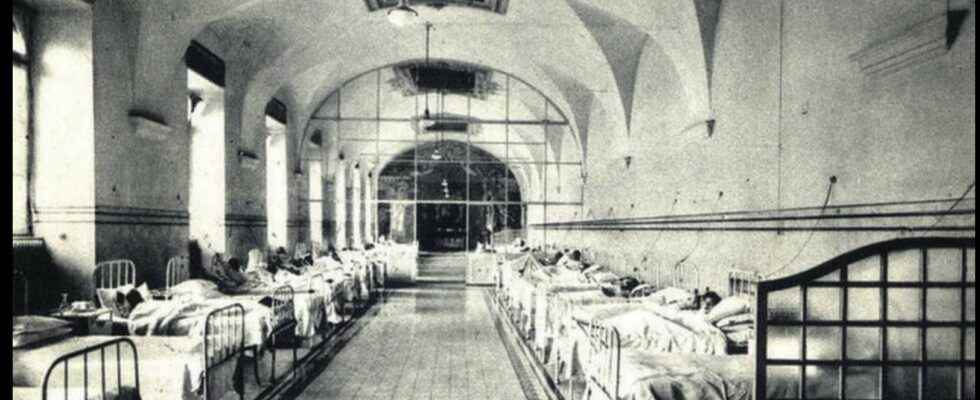In a Rome occupied by the German army, a strange disease appears at the Fatebenefratelli hospital, on the island of Tiberina: syndrome K. Its victims – Jews, homosexuals, political opponents of the Nazi regime – perish , it is said, in the clutches of this terrible epidemic behind the closed doors of the institution. But Syndrome K does not exist because, behind this bloodcurdling name, there are actually three doctors, united in their desire to save the lives threatened by the roundup.
You will also be interested
October 1943. Second World War. The Nazi army holds the streets of Rome with an iron fist. Its flag floats throughout the city, as far as St. Peter’s Square, under the Windows from the pope. On Himmler’s orders, the Jews of the city are hunted down with a view to their future deportation to the extermination camps.
On Tiberina Island, in the center of Rome, Doctor Giovanni Borromeo, director of the Fatebenefratelli hospital, and his two colleagues Vittorio Sacerdoti and Adriano Ossicini, are on all fronts. In the corridors of their hospital, a very aggressive and totally unknown disease is spreading like wildfire. The existence of this terrible epidemic reached the ears of the Nazi soldiers who remained at a safe distance from Fatebenefratelli.
To prevent the mysterious microbe contaminates the whole city, the infected are quarantined in the basement of the hospital. Rumor has it that people with syndrome K go crazy, their body twists in all directions under violent seizures. They end up being totally paralyzed, unable to breathe and see themselves dying painfully fromasphyxia. Nobody wants to approach the Fatebenefratelli hospital, and especially not the German soldiers.
Roundup in the Rome ghetto
But, on October 15, 1943, the high-ranking German, in charge of the nazi soldiers in Rome, orders a roundup in the city’s ghetto. The Rabbi of Rome and the Pope promise 50 kilos of gold to the soldier in exchange for the lives of thousands of Jews in the ghetto. They provide the gold, but the roundup is still ordered: 1,259 Jews are rounded up and sent to Auschwitz. Only sixteen of them will survive.
In panic, families took refuge on Tiber Island, towards the hospital located just opposite the ghetto. The soldiers pursue them but stop short when they arrive at Fatebenefratelli. Doctors Borromeo, Sacerdoti and Ossicini, with serious faces and drawn features, tell them of the catastrophic situation in the hospital. Quarantine was not enough to contain Syndrome K. Nurses, doctors and the religious who officiate in the hospital are dropping like flies. The sick are screaming pain and spit out their entrails before fading away in a tormented expression.
The soldiers turn pale as sheets. From the depths of the hospital they can hear the agonizing cries of the sick. None of them want to take that risk! They turn back, fear stuck deep inside eyes.
A disease that saves lives
The three doctors exchange a relieved look. In the basement of the hospital, patients with a K in their medical records are not sick. Well, not in the eyes of medicine. They are Jews, Poles, homosexuals, Gypsies, the disabled or even political opponents. All those deemed harmful and undesirable by the Nazi regime. The hospital also takes care of resistance fighters hidden around Rome.
Syndrome K: what a formidable disease, capable of saving lives! The three friends had the brilliant idea of inventing it from scratch to keep the Germans away. Once protected in the hospital, staff and clerics provide Jews, and everyone else, with forged papers and passes allowing them to leave Rome for less exposed countryside monasteries.
Thanks to this imaginary disease, the German soldiers will no longer come to put the nose in the affairs of the hospital until the liberation of Rome on June 15, 1944. During this time, the efforts of Doctors Borromeo, Sacerdoti and Ossicini made it possible to save the lives of a hundred people.
righteous among the nations
Giovanni Borromeo will be rewarded for his action by Israel. He is recognized as “Righteous Among the Nations”, and his name is inscribed on the memorial to the victims of the Shoah in Jerusalem. He died in 1961 in the Fatebenefratelli hospital.
If syndrome K refers to the Koch’s bacillusAdriano Ossicini, anti-fascist like his colleagues, sees in it a reference to two other microbes, of a completely different genre: Albert Kesselring, at the head of the Nazi campaign in Italy and Herbert Kappler, the commander who ordered the roundup of the ghetto in Rome.
Interested in what you just read?
